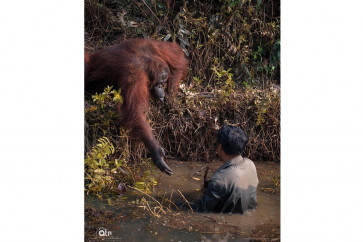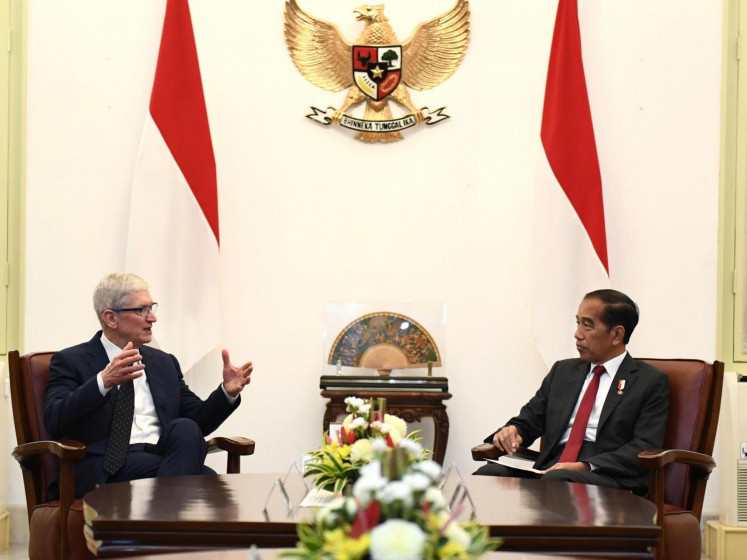Urban Chat: Beyond lion dances and red lanterns at fancy malls
I spent my formative years in a low-key neighborhood near where Central, West and South Jakarta converge
Change Size

I
spent my formative years in a low-key neighborhood near where Central, West and South Jakarta converge. My classmates were the local Betawi kids, some of us 'newcomers' and a lone Chinese boy named Icong.
Icong came from one of the neighborhood's two Chinese families. The differences between him and Aan, the other Chinese boy living in a duplex across our rented house, were that Icong's family lived behind their mom-and-dad's warung and Aan went to a Catholic school. Mom wished she could have afforded to send me too.
They say no theories imprint understanding better than experiences. I learned early in life that not all Chinese descendants were Mercedes-riding, smug bourgeoisie. Aan's bike was fancier than mine but Icong didn't even own one. Aan celebrated Christmas while Icong brought kue keranjang (glutinous cakes) to school during Chinese New Year. Both boys laughed when hearing jokes and bled when falling down during games. Both were different to one another, yet both were just like me.
I since lost contact with them but they are why I never separated my Chinese and Melayu friends. My first college internship was in the property sector, where Chinese-Indonesians were my primary clients, while my first full-time job was in the capital market where Chinese- Indonesians were my primary colleagues ' whom I braved the terrifying May 1998 riots with.
And that is one sad fact that has marred so many upheavals across the archipelago since modern Chinese immigrants started arriving a few hundred years ago ' they often bore the much-untold brunt (Remy Sylado's 1999 novel Cabaukan and FX Harsono's series of art installations are interesting reference points to start with). The Dutch colonialists first initiated segregation by assigning different class systems and eligible working sectors between indigenous Malays and Chinese migrants.
The two ethics huddled together in the pivotal years leading to independence in 1945, and Sukarno did his best to assimilate us further by inviting Chinese-Indonesians into his cabinet, but later Soeharto used the convoluted 1965-66 conflicts to reverse things for the next 32 years. The Chinese-Indonesians were omitted or opaquely portrayed in history textbooks. Banned from the military and government, they were pushed into entrepreneurship, using their gift for adapting with difficult situations, and as economy soars so does their population and, hence, seemingly more seperated than the Malays and inviting all kinds of misunderstanding and jealousy, becoming bull's-eyes for collective anger when things go awry.
Quite ironically, history has long suggested that the ancestors of so-called indigenous Malays arrived from Southern China thousands of years ago anyway. We are all Chinese descendants ' our forebears just landed over different periods that were spaced apart.
Post Reformasi 1998, the Chinese descendants have received long overdue governmental nods for the inclusion of the Lunar New Year into the official calendar and Konghucu (Confucianism) as an official faith. Sadly, community-based initiatives are still far and few, hence noteworthy praise should be reserved for the Benteng Heritage Museum (BHM) in Tangerang, a short drive from Jakarta.
Founded a couple of years ago on a relatively well-preserved 200-year-old Chinese ruko (shop-house) filled with antique memorabilia of the lives of bygone Chinese diaspora, BHM set out to tell the forgotten heritage of Benteng, a riverbank delta bustling since the days it marked the border between the Banten and Jayakarta monarchies.
The delta where Chinese immigrants have assimilated with indigenous Malays for generations, traced clearly on the simple faces peddling cakes, knickknacks and cut flowers in the muddy Tangerang old market, is where the BHM is tucked into ' a far cry from the rich Chinese tycoons that people often envisage. For a few flashback moments, I had Icong's family on my mind.
My friends and I were lucky to meet founder Udaya Halim when we recently visited the BHM and a 300-year-old Chinese temple nearby. A son of a modest local Chinese family who now runs a respectable English language school, Udaya generously decided to take time out of his busy schedule to share a well-researched presentation and gave a tour while we viewed his private collection of vintage, historically disavowed materials associated with the Chinese diaspora beyond Benteng.
What was supposed to be a one-hour visit ended up being a half-day blast filled with history lessons, tale swaps, massive picture hunting and, at one point, impromptu dancing accompanied by peals of laughter when Udaya put on a 1940s-jazz-record onto his 1904 gramophone.
Indonesian history is full of gaping holes, half of which are possibly engineered, and our education system, even after the 1998 Reformasi, has not really done a good job in catching up.
The age-old tradition of verbally passing down history is not only bias, it is now waning ' one example being that my Betawi cousins and friends proudly assume that Muslim Arabic is the only heritage they carry, oblivious to how close their mother's bridal gown resemble those of Chinese brides or how similar gambang kromong sounds to Portuguese folksongs.
Beyond festive lion dances and red décor at malls, we must revisit our past, research the historical gaps with open minds, before we can close the complicated ethnic gaps in the future. To all my Chinese Indonesian friends ' Hokkien, Khek, and Tiochu alike ' Gong Xi Fa Cai.
Lynda Ibrahim is a Jakarta-based writer and consultant, who loves purple, pussycats and pop culture.









